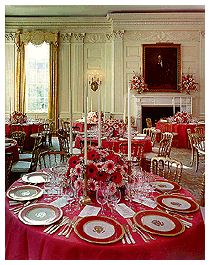|
| |
| |
Welcome to the State Dining Room
The State Dining Room, which now seats as many as 140 guests, was originally much smaller and served at various times as a drawing room, office, and Cabinet Room. Not until the Andrew Jackson administration was it called the "State Dining Room," although it had been used for formal dinners by previous Presidents. As the nation grew, so did the invitation list to official functions at the White House. After the renovation of 1902 by architects McKim, Mead & White, the room size was enlarged after the main stairway from the west end of the Cross Hall was removed. The two Italian marble mantels installed by Monroe were moved to the Red and Green Rooms; a single larger fireplace was constructed on the west wall. The architecture of the room was modeled after that of neoclassical English houses of the late 18th century. Below a new ceiling and a cornice of white plaster, natural oak wall paneling with Corinthian pilasters and a delicately carved frieze were installed. Three console tables with eagle supports, made by the A. H. Davenport Co. of Boston, were placed against the walls, and a silver-plate chandelier and complementing wall sconces were added. In this picture the mahogany dining table, surrounded by Queen Anne-style chairs, displays part of Monroe's gilt service purchased from France in 1817. The ornamental bronze-dore pieces are used today as table decorations for state dinners. The plateau centerpiece, with seven mirrored sections, measures 13 feet 6 inches in length when fully extended. Standing bacchantes holding wreaths for tiny bowls or candles border the plateau. Three fruit baskets, supported by female figures, may be used to hold flowers. The two rococo-revival candelabra date from the Hayes Administration. The carpet, of soft green and brown, reproduces a Persian design from the 17th century. Carved into the mantel below George P. A. Healy's portrait of President Lincoln is an inscription from a letter written by John Adams on his second night in the White House: I pray Heaven to Bestow the Best of Blessings on THIS HOUSE and on All that shall hereafter Inhabit it. May none but honest and Wise Men ever rule this roof.
President and First Lady | Vice President and Mrs. Gore |
|